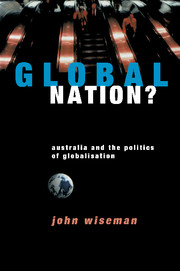Book contents
- Frontmatter
- Contents
- Abbreviations
- Acknowledgments
- 1 Introduction: Australia and the Politics of Globalisation
- 2 Breaking the Spell? Understanding Globalisation
- 3 Transforming the Global Economy? Trade, Capital and Power in the Late Twentieth Century
- 4 Onto the Global Racetrack? Globalising the Australian Economy
- 5 The Price of Competitiveness? The Social Impact of Globalisation on Australia
- 6 Wired to the World? Australia and the Globalisation of Media and Information Technologies
- 7 Nowhere to Hide? Australia in the Global Environment
- 8 Where in the World? Transforming Australian Political Relationships and National Identities
- 9 Alternative Strategies? Thinking and Acting Globally and Regionally
- 10 Alternative Directions? Thinking and Acting Locally and Nationally
- 11 Conclusion
- Notes
- Bibliography
- Index
8 - Where in the World? Transforming Australian Political Relationships and National Identities
Published online by Cambridge University Press: 20 May 2010
- Frontmatter
- Contents
- Abbreviations
- Acknowledgments
- 1 Introduction: Australia and the Politics of Globalisation
- 2 Breaking the Spell? Understanding Globalisation
- 3 Transforming the Global Economy? Trade, Capital and Power in the Late Twentieth Century
- 4 Onto the Global Racetrack? Globalising the Australian Economy
- 5 The Price of Competitiveness? The Social Impact of Globalisation on Australia
- 6 Wired to the World? Australia and the Globalisation of Media and Information Technologies
- 7 Nowhere to Hide? Australia in the Global Environment
- 8 Where in the World? Transforming Australian Political Relationships and National Identities
- 9 Alternative Strategies? Thinking and Acting Globally and Regionally
- 10 Alternative Directions? Thinking and Acting Locally and Nationally
- 11 Conclusion
- Notes
- Bibliography
- Index
Summary
We can only play a part in [the region] if we go to the world as one nation, as a nation united and not a nation in any way divided. That is why Australians need to be clear about their identity and proud of it. That is why you can't go hobbling to the world saying: ‘Please put us in the big race, but by the way our indigenes don't have a real part of it and by the way, we are still borrowing the monarchy of another country’.
Paul KeatingNational identity develops in an organic way over time. It may be changed by cataclysmic events like Gallipoli. But government and their social engineers should not try to manipulate it or to create a sense of crisis about identity. Constant debate about identity implies that we don't already have one, or worse, that it is somehow inadequate.
John HowardOctober 1997. Global speculators begin their attack on the currencies of South East Asia and the headlines in regional newspapers rapidly become apocalyptic. ‘Sharemarket Meltdown’; ‘IMF Intervenes in Thailand and Indonesia’; ‘Malaysian Ringgit falls thirty per cent’.
The Hong Kong stockmarket collapses and there is talk of ‘global fallout’. Wall Street and the other northern stockmarkets gyrate wildly. It is clear that Australia will not be immune, but there is widespread confusion about the long-term implications. ‘Don't Panic!’ advise the financial gurus.
- Type
- Chapter
- Information
- Global Nation?Australia and the Politics of Globalisation, pp. 101 - 115Publisher: Cambridge University PressPrint publication year: 1998

